Gas Permeability Prediction of Mortar Samples Based on Different Methods
Abstract
:1. Introduction
2. Materials and Methods
2.1. Materials and Sample Preparation
2.2. Experimental Procedures
2.2.1. Measurement of Gas Permeability
2.2.2. BSE Observation
2.2.3. MIP Analyze
2.3. BSE Image Preprocessing
2.4. Calculation Methods of Gas Permeability
2.4.1. Gas Permeability Estimation from the BSE Image
2.4.2. Katz–Thompson Equation
2.4.3. Winland Model
3. Results and Discussion
3.1. Gas Permeability Measured by Laboratory Test
3.2. Image Processing Results of Mortar Sample
3.3. Pore Structure Characteristics from MIP
3.4. Gas Permeabilities Obtained from Different Methods
4. Conclusions
- (1)
- The BSE image binarization processing performed by using Yen’s algorithm and the watershed algorithm are used to obtain the pore size distribution from the binarized BSE image. The algorithms can effectively extract pore structure information; the extracted pores are capillary pores with diameters ranging from 0.04 to 1 μm. The gas permeability estimated from the BSE image differs with different image magnification; a high magnification BSE image results in a lower calculated value. However, the calculated permeabilities from a 1000 times magnification BSE image are about 1.5–3 times higher than the measured values from laboratory tests, while the gas permeabilities predicted from a 4000 times BSE image are approximately 5 times lower than actual values. The deviation is mainly because this method cannot easily and completely display the actual pore structure; it is limited by the scope of observation and magnification.
- (2)
- MIP technology can reveal the pore distribution characteristic of the mortar sample more comprehensively; the measured pore size distribution range and the porosity are larger than that obtained from the BSE image. All the pore types in the mortar sample, including air voids, capillary pores, and parts of the gel pores, can be characterized by the MIP test. The critical pore diameters of the three samples are 69.01, 49.91, and 14.13 nm for samples SF0, SF5 and SF10, respectively. The permeabilities predicted by using the Katz–Thompson equation are approximately two orders of magnitude lower than the measured value. The Katz–Thompson equation only uses the critical pore diameter and neglects the contribution of coarse capillary pores on gas permeability.
- (3)
- The Winland model uses the pore diameter when cumulative mercury saturation reaches 35% and empirical parameters calibrated from the experimental data of sandstone and carbonates. The gas permeabilities calculated by the Winland model are very close to the measured gas permeabilities.
Author Contributions
Funding
Institutional Review Board Statement
Informed Consent Statement
Data Availability Statement
Conflicts of Interest
References
- Hamami, A.A.; Turcry, P.; Aït-Mokhtar, A. Influence of mix proportions on microstructure and gas permeability of cement pastes and mortars. Cem. Concr. Res. 2012, 42, 490–498. [Google Scholar] [CrossRef]
- Salvoldi, B.G.; Beushausen, H.; Alexander, M.G. Oxygen permeability of concrete and its relation to carbonation. Constr. Build. Mater. 2015, 85, 30–37. [Google Scholar] [CrossRef]
- Zhang, X.; Zhou, X.; Zhou, H.; Gao, K.; Wang, Z. Studies on forecasting of carbonation depth of slag high performance concrete considering gas permeability. Appl. Clay Sci. 2013, 79, 36–40. [Google Scholar] [CrossRef]
- Neves, R.; Da Fonseca, B.S.; Branco, F.; De Brito, J.; Castela, A.; Montemor, M.F. Assessing concrete carbonation resistance through air permeability measurements. Constr. Build. Mater. 2015, 82, 304–309. [Google Scholar] [CrossRef]
- Gui, Q.; Qin, M.; Li, K. Gas permeability and electrical conductivity of structural concretes: Impact of pore structure and pore saturation. Cem. Concr. Res. 2016, 89, 109–119. [Google Scholar] [CrossRef]
- Abbas, A.; Carcassès, M.; Ollivier, J.P. The importance of gas permeability in addition to the compressive strength of concrete. Mag. Concr. Res. 2000, 52, 1–6. [Google Scholar] [CrossRef]
- Zhang, X.; Li, Z.; Ma, Q.; Zhou, X.; Wang, Q. Study on the correlation between SHPC pore structure and air permeability. Teh. Vjesn.-Tech. Gaz. 2017, 24, 1425–1430. [Google Scholar] [CrossRef] [Green Version]
- Wu, Z.; Wong, H.; Buenfeld, N. Influence of drying-induced microcracking and related size effects on mass transport properties of concrete. Cem. Concr. Res. 2014, 68, 35–48. [Google Scholar] [CrossRef] [Green Version]
- Wu, Z.; Wong, H.; Buenfeld, N. Transport properties of concrete after drying-wetting regimes to elucidate the effects of moisture content, hysteresis and microcracking. Cem. Concr. Res. 2017, 98, 136–154. [Google Scholar] [CrossRef]
- Chen, X.-T.; Caratini, G.; Davy, C.; Troadec, D.; Skoczylas, F. Coupled transport and poro-mechanical properties of a heat-treated mortar under confinement. Cem. Concr. Res. 2013, 49, 10–20. [Google Scholar] [CrossRef]
- Ye, B.; Cheng, Z.; Ni, X. Effects of multiple heating-cooling cycles on the permeability and microstructure of a mortar. Constr. Build. Mater. 2018, 176, 156–164. [Google Scholar] [CrossRef]
- Wong, H.; Buenfeld, N.; Head, M. Estimating transport properties of mortars using image analysis on backscattered electron images. Cem. Concr. Res. 2006, 36, 1556–1566. [Google Scholar] [CrossRef] [Green Version]
- Wong, H.; Zimmerman, R.; Buenfeld, N. Estimating the permeability of cement pastes and mortars using image analysis and effective medium theory. Cem. Concr. Res. 2011, 42, 476–483. [Google Scholar] [CrossRef] [Green Version]
- Wei, Y.; Guo, W.; Wu, Z.; Gao, X. Computed permeability for cement paste subject to freeze-thaw cycles at early ages. Constr. Build. Mater. 2020, 244, 118298. [Google Scholar] [CrossRef]
- Tsivilis, S.; Chaniotakis, E.; Batis, G.; Meletiou, C.; Kasselouri, V.; Kakali, G.; Psimadas, C. The effect of clinker and limestone quality on the gas permeability, water absorption and pore structure of limestone cement concrete. Cem. Concr. Compos. 1999, 21, 139–146. [Google Scholar] [CrossRef]
- Sakai, Y. Correlations between air permeability coefficients and pore structure indicators of cementitious materials. Constr. Build. Mater. 2019, 209, 541–547. [Google Scholar] [CrossRef]
- Wang, L.; Jin, M.; Guo, F.; Wang, Y.; Tang, S. Pore structural and fractal analysis of the influence of fly ash and silica fume on the mechanical property and abrasion resistance of concrete. Fractals 2021, 29, 2140003. [Google Scholar] [CrossRef]
- Cheng, Z.; Ye, B.; Zhao, J. Investigation of the Gas Breakthrough Pressure of Cement Mortar with Different Experimental Techniques. KSCE J. Civ. Eng. 2021, 26, 325–335. [Google Scholar] [CrossRef]
- Klinkenberg, L.J. The permeability of porous media to liquids and gases. Socar Proc. 1941, 2, 200–213. [Google Scholar] [CrossRef]
- Münch, B.; Holzer, L. Contradicting geometrical concepts in pore size analysis attained with electron microscopy and mercury intrusion. J. Am. Ceram. Soc. 2008, 91, 4059–4067. [Google Scholar] [CrossRef]
- Song, S.-B.; Liu, J.-F.; Yang, D.-S.; Ni, H.-Y.; Huang, B.-X.; Zhang, K.; Mao, X.-B. Pore structure characterization and permeability prediction of coal samples based on SEM images. J. Nat. Gas Sci. Eng. 2019, 67, 160–171. [Google Scholar] [CrossRef]
- Yen, J.C.; Chang, F.-J.; Chang, S. A new criterion for automatic multilevel thresholding. IEEE Trans. Image Process. 1995, 4, 370–378. [Google Scholar] [CrossRef] [PubMed]
- Rabbani, A.; Salehi, S. Dynamic modeling of the formation damage and mud cake deposition using filtration theories coupled with SEM image processing. J. Nat. Gas Sci. Eng. 2017, 42, 157–168. [Google Scholar] [CrossRef]
- Laskar, A.; Kumar, R.; Bhattacharjee, B. Some aspects of evaluation of concrete through mercury intrusion porosimetry. Cem. Concr. Res. 1997, 27, 93–105. [Google Scholar] [CrossRef]
- Manickam, S.S.; Gelb, J.; McCutcheon, J.R. Pore structure characterization of asymmetric membranes: Non-destructive characterization of porosity and tortuosity. J. Membr. Sci. 2014, 454, 549–554. [Google Scholar] [CrossRef]
- Katz, A.J.; Thompson, A.H. Prediction of rock electrical conductivity from mercury injection measurements. J. Geophys. Res.-Solid Earth 1987, 92, 599–607. [Google Scholar] [CrossRef]
- Halamickova, P.; Detwiler, R.J.; Bentz, D.P.; Garboczi, E.J. Water permeability and chloride ion diffusion in Portland cement mortars: Relationship to sand content and critical pore diameter . Cem. Concr. Res. 1995, 25, 790–802. [Google Scholar] [CrossRef]
- Kolodzie, S.J. Analysis of pore throat size and use of the Waxman-Smits equation to determine OOIP in spindle field. In Proceedings of the SPE Annual Technical Conference and Exhibition, Dallas, TX, USA, 21–24 September 1980. [Google Scholar]
- Liu, J.; Song, S.; Cao, X.; Meng, Q.; Pu, H.; Wang, Y. Determination of full-scale pore size distribution of Gaomiaozi bentonite and its permeability prediction. J. Rock Mech. Geotech. Eng. 2020, 12, 403–413. [Google Scholar] [CrossRef]
- Wu, Z.; Shi, C.; Khayat, K. Influence of silica fume content on microstructure development and bond to steel fiber in ultra-high strength cement-based materials (UHSC). Cem. Concr. Compos. 2016, 71, 97–109. [Google Scholar] [CrossRef] [Green Version]
- Oltulu, M.; Sahin, R. Pore structure analysis of hardened cement mortars containing silica fume and different nano-powders. Constr. Build. Mater. 2014, 53, 658–664. [Google Scholar] [CrossRef]
- Zeng, Q.; Li, K.F.; Chong, T.F.; Dangla, P. Pore structure characterization of cement pastes blended with high-volume flyash. Cem. Concr. Res. 2012, 42, 194–204. [Google Scholar] [CrossRef]
- Wong, H.; Pappas, A.; Zimmerman, R.; Buenfeld, N. Effect of entrained air voids on the microstructure and mass transport properties of concrete. Cem. Concr. Res. 2011, 41, 1067–1077. [Google Scholar] [CrossRef] [Green Version]
- Zhang, J.; Bian, F.; Zhang, Y.; Fang, Z.; Fu, C.; Guo, J. Effect of pore structures on gas permeability and chloride diffusivity of concrete. Constr. Build. Mater. 2018, 163, 402–413. [Google Scholar] [CrossRef]
- Yio, M.; Wong, H.; Buenfeld, N. 3D pore structure and mass transport properties of blended cementitious materials. Cem. Concr. Res. 2018, 117, 23–37. [Google Scholar] [CrossRef]
- Song, Y.; Dai, G.; Zhao, L.; Bian, Z.; Li, P.; Song, L. Permeability prediction of hydrated cement paste based on its 3D image analysis. Constr. Build. Mater. 2020, 247, 118527. [Google Scholar] [CrossRef]
- Care, S.; Derkx, F. Determination of relevant parameters influencing gas permeability of mortars. Constr. Build. Mater. 2011, 25, 1248–1256. [Google Scholar] [CrossRef]
- Cheng, Z.; Zhao, J.; Cui, L. Exploration of hydration and durability properties of ferroaluminate cement with compare to Portland cement. Constr. Build. Mater. 2021, 319, 126138. [Google Scholar] [CrossRef]

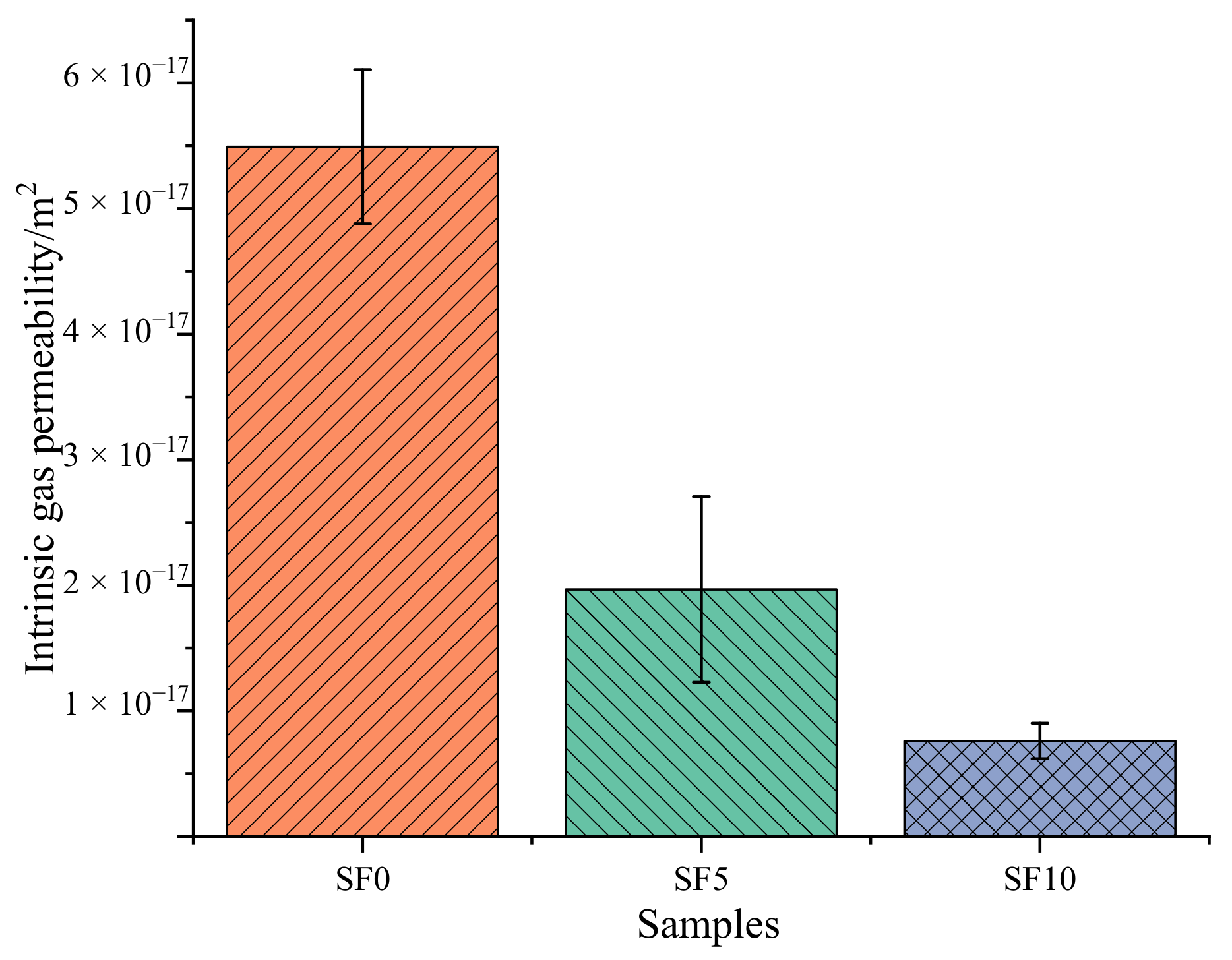

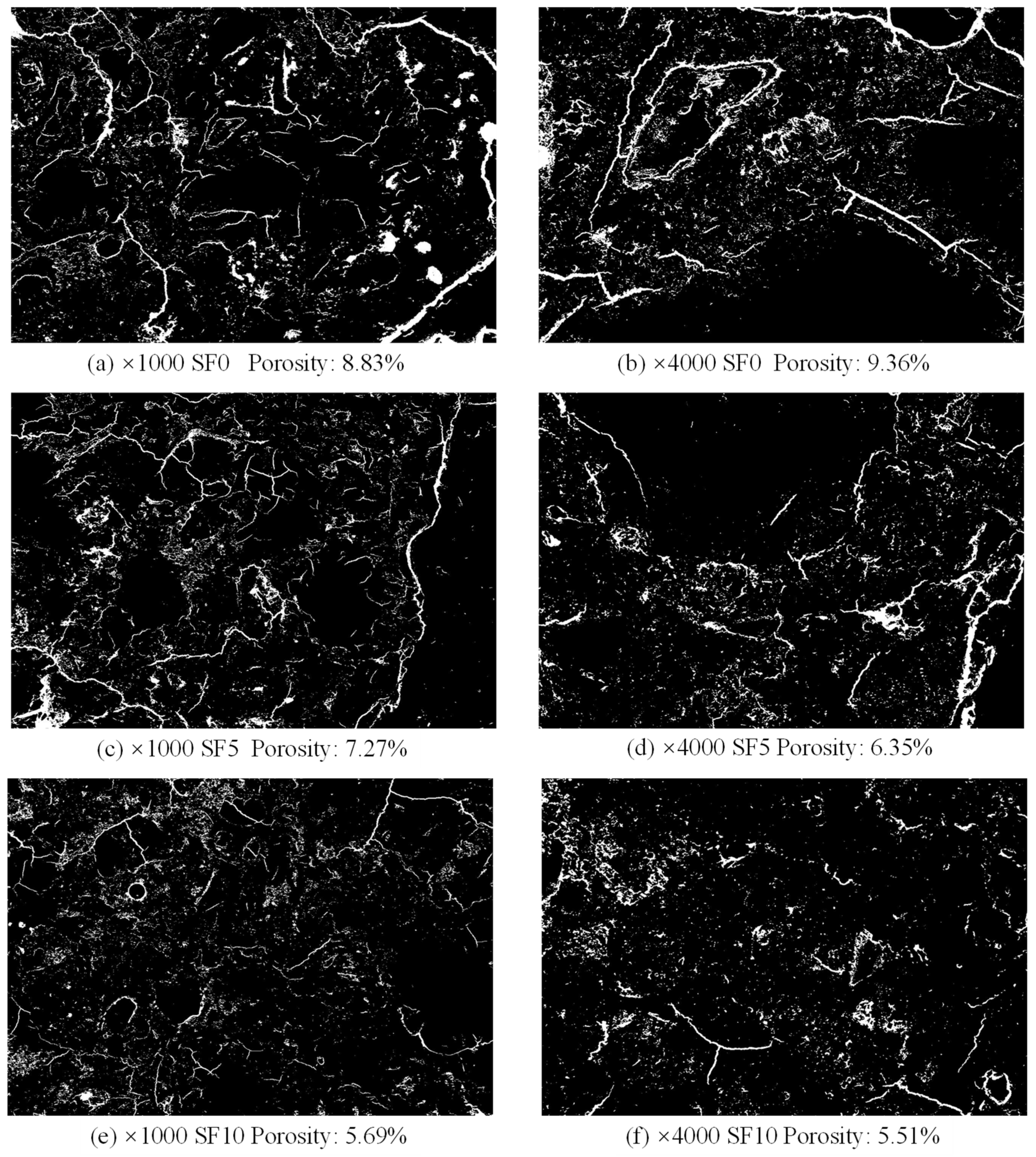
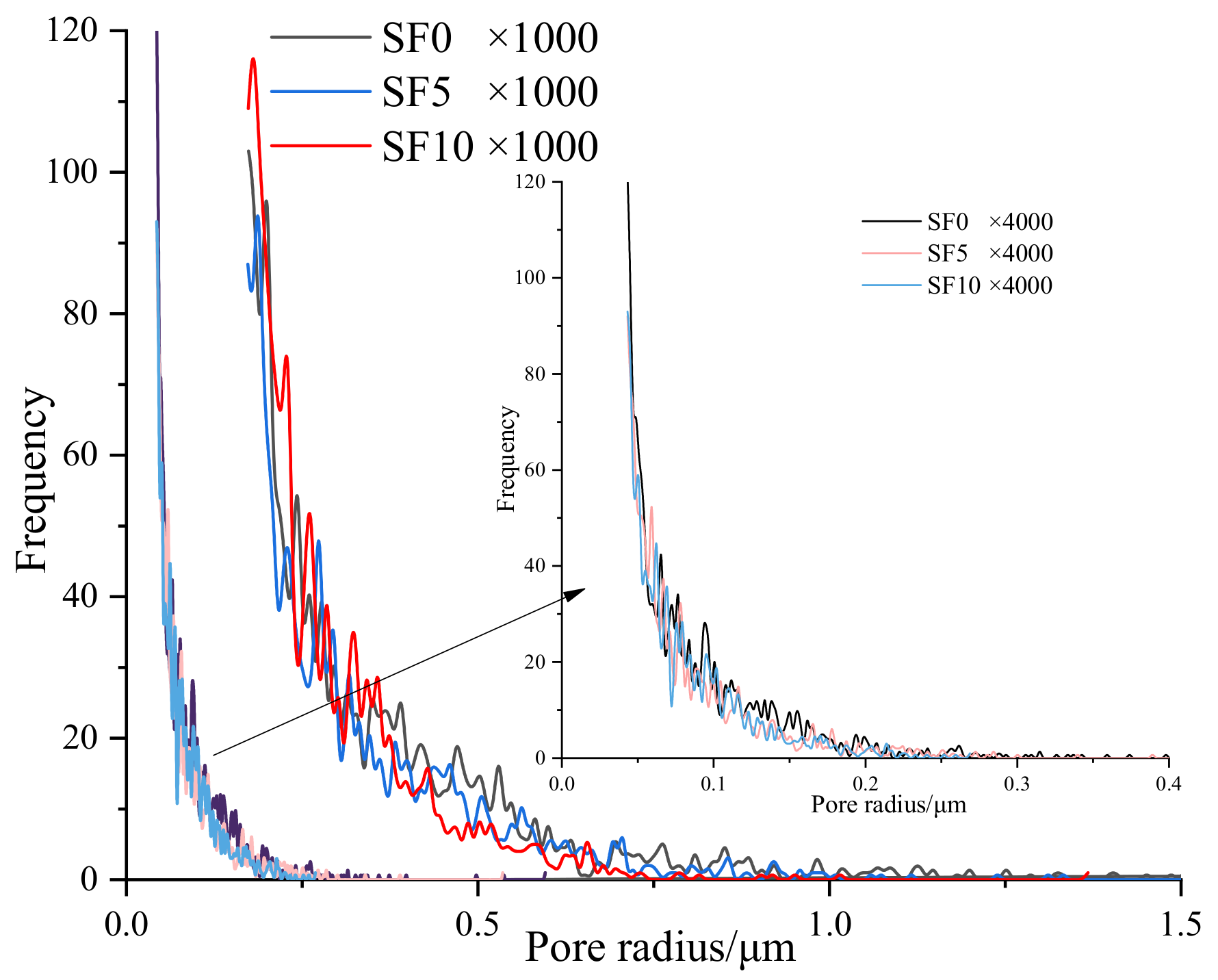

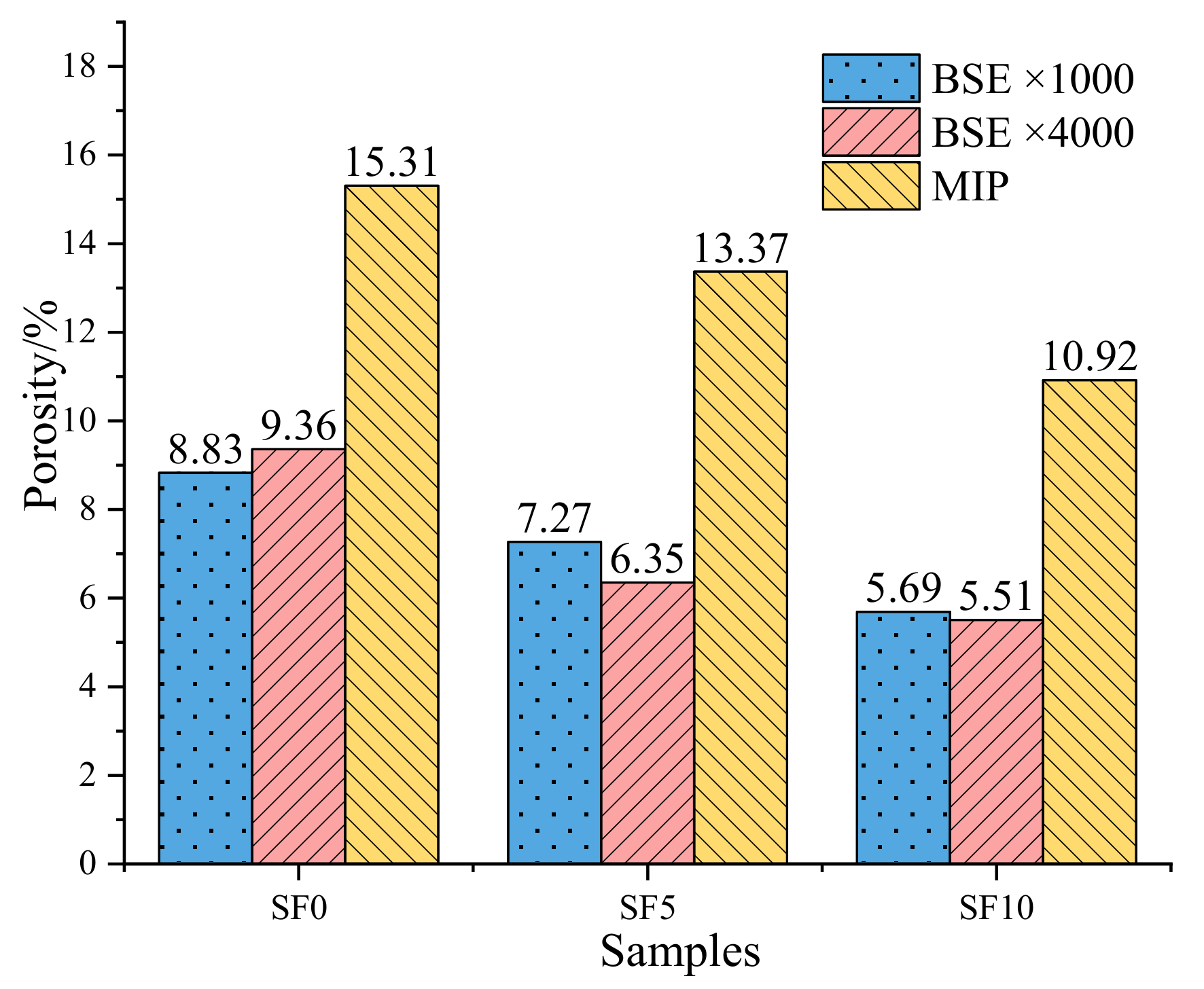
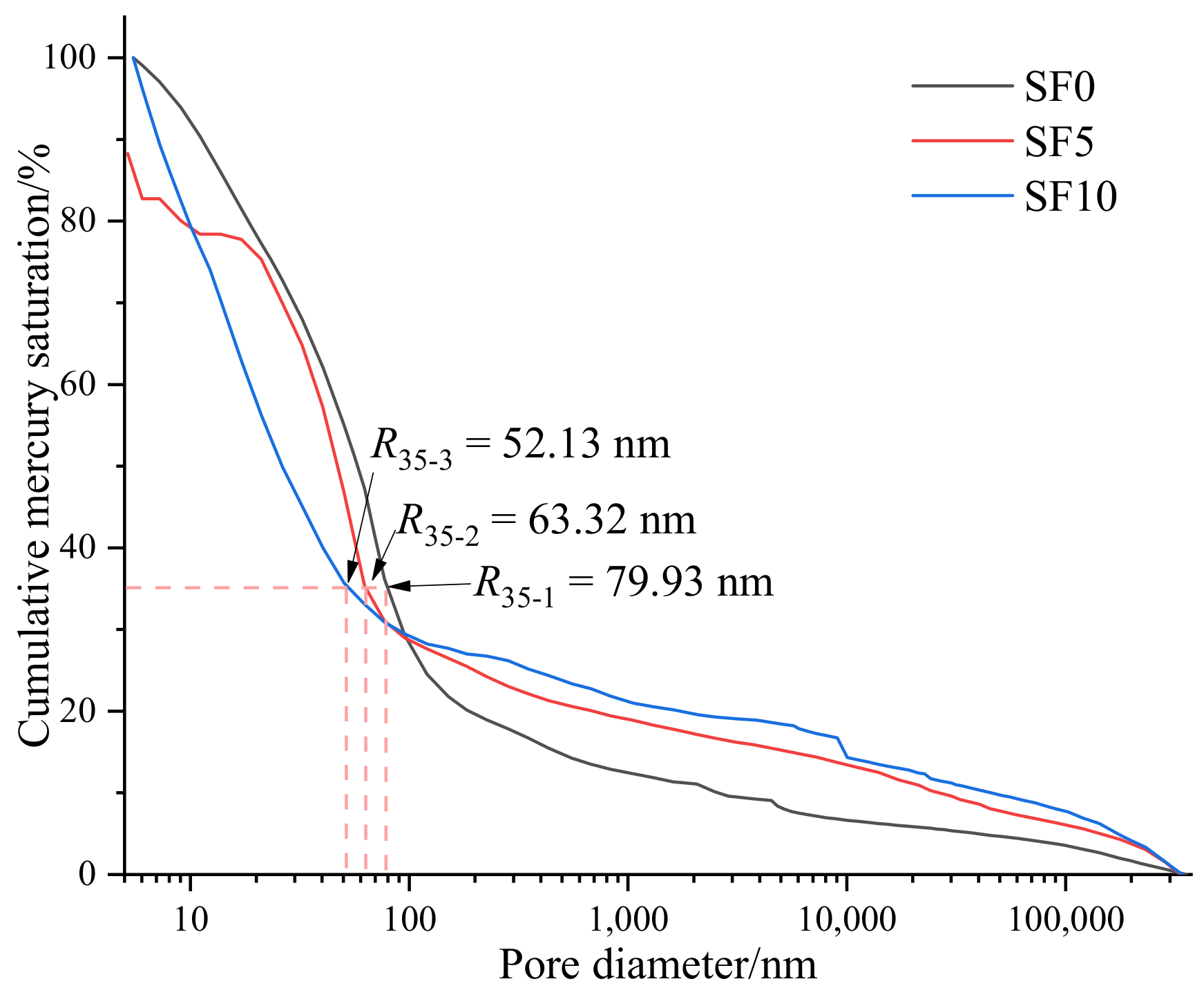
| Compositions (wt. %) | Loss (%) | BS (m2/kg) | ||||||||
|---|---|---|---|---|---|---|---|---|---|---|
| SiO2 | Al2O3 | CaO | SO3 | MgO | Na2O | K2O | Fe2O3 | |||
| Cement | 21.58 | 5.16 | 63.05 | 2.57 | 1.57 | 0.27 | 0.31 | 3.39 | 3.1 | 316 |
| Silica fume | 95.3 | - | 1.15 | - | 0.17 | 0.17 | 0.46 | 0.29 | 0.3 | - |
| Mixtures | w/c | Mass of Ingredient (g) | |||
|---|---|---|---|---|---|
| Cement | Silica Fume | Standard Sand | Water | ||
| SF0 | 0.5 | 450 | 0 | 1350 | 225 |
| SF5 | 0.5 | 427.5 | 22.5 | 1350 | 225 |
| SF10 | 0.5 | 405 | 45 | 1350 | 225 |
| Samples | Experimental k (m2) | Calculate k with Different Methods (m2) | |||
|---|---|---|---|---|---|
| BSE × 1000 | BSE × 4000 | K–T Model | Winland Model | ||
| SF0 | 5.49 × 10−17 | 1.75 × 10−16 | 0.93 × 10−17 | 8.03 × 10−19 | 4.13 × 10−17 |
| SF5 | 1.97 × 10−17 | 4.01 × 10−17 | 4.36 × 10−18 | 3.89 × 10−19 | 2.32 × 10−17 |
| SF10 | 7.61 × 10−18 | 1.02 × 10−17 | 1.91 × 10−18 | 3.28 × 10−20 | 1.24 × 10−17 |
Publisher’s Note: MDPI stays neutral with regard to jurisdictional claims in published maps and institutional affiliations. |
© 2022 by the authors. Licensee MDPI, Basel, Switzerland. This article is an open access article distributed under the terms and conditions of the Creative Commons Attribution (CC BY) license (https://creativecommons.org/licenses/by/4.0/).
Share and Cite
Cheng, Z.; Wang, Y.; Zhao, J.; Huang, C. Gas Permeability Prediction of Mortar Samples Based on Different Methods. Crystals 2022, 12, 581. https://doi.org/10.3390/cryst12050581
Cheng Z, Wang Y, Zhao J, Huang C. Gas Permeability Prediction of Mortar Samples Based on Different Methods. Crystals. 2022; 12(5):581. https://doi.org/10.3390/cryst12050581
Chicago/Turabian StyleCheng, Zirui, Yiren Wang, Jihui Zhao, and Chunlong Huang. 2022. "Gas Permeability Prediction of Mortar Samples Based on Different Methods" Crystals 12, no. 5: 581. https://doi.org/10.3390/cryst12050581






